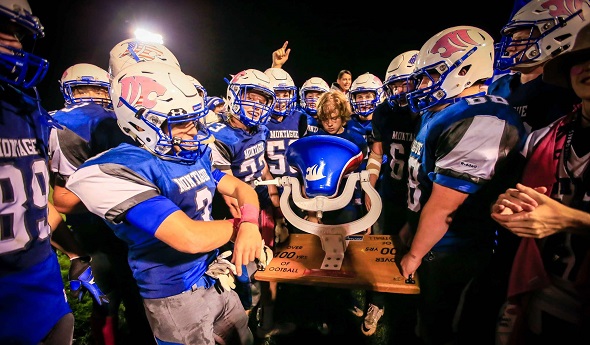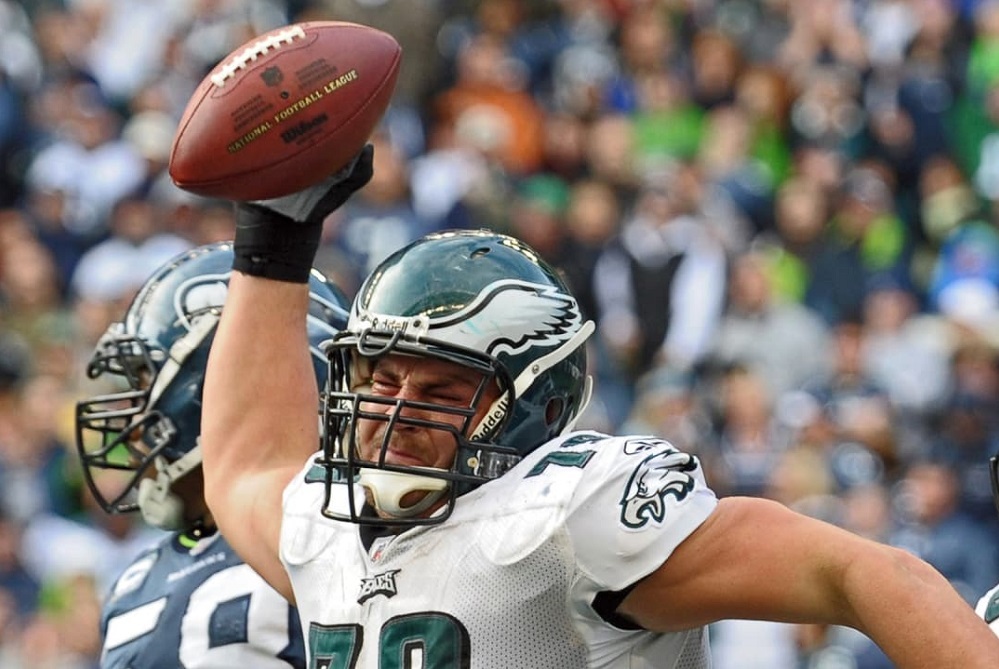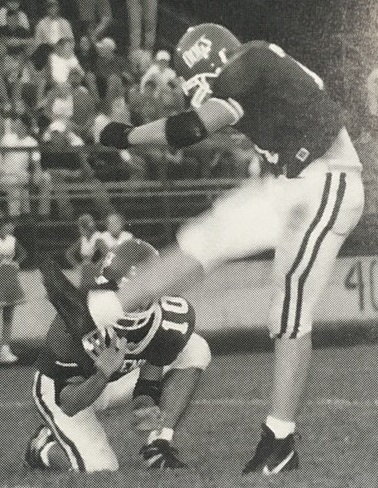
'Battle for the Bell' Rings for 110th Tilt
October 5, 2016
By Tom Kendra
Special for Second Half
The Whitehall vs. Montague football game actually begins on Thursday night far away from any football field, with a huge crowd from each town, bands, cheerleaders, players, coaches and school officials.
 For the coin toss.
For the coin toss.
In a scene reminiscent of a Revolutionary War battle, the aforementioned delegations marched toward each other on the evening of Thursday, Sept. 22, and met – Whitehall in red and Montague in blue – on the bridge over the White River, which separates the two northern Muskegon County towns.
No shots were fired or punches thrown, but simply a coin was tossed high in the air by veteran MHSAA official Chuck Hulce (who, by the way, coached Montague from 1969 to 1977 and then Whitehall from 1979 to 1981) and the 110th edition of the “The Battle for the Bell” was underway.
“This is something I’ve been dreaming about my whole life – playing Whitehall, the cross-town rival where I know everyone, my senior year,” said Montague senior wide receiver Josh Weesies. “It’s huge for me. We’ve been grinding all summer just thinking about this game.”
Montague, with a population of 2,361 and covering 3.27 square miles, boasts the World’s Largest Working Weathervane and 1961 Miss America Nancy Fleming – and boasted a 59-48-2 edge in the all-time series over Whitehall heading into this year’s game.
Whitehall, with a population of 2,706 and covering 3.79 square miles, counters with the historic Howmet Playhouse and 11-year Major League Baseball player and Gold Glove winner Nate McLouth, who quarterbacked the Vikings to back-to-back wins in the series in 1998 and 1999.
The game has always been about bragging rights, but this year’s clash was much more. For the first time since 1985, both teams came into the game undefeated and both were state-ranked. Whitehall was 4-0 and ranked eighth in the Associated Press Division 4 poll, while Montague was also 4-0 and ranked sixth in Division 5.
 The pre-game festivities on Sept. 22 were all about White Lake area unity as the two communities came together for a “Pink Out” event to raise money for St. Jude’s Hospital and the fight against cancer – and the marching bands even performed together on the field before the game.
The pre-game festivities on Sept. 22 were all about White Lake area unity as the two communities came together for a “Pink Out” event to raise money for St. Jude’s Hospital and the fight against cancer – and the marching bands even performed together on the field before the game.
Then it was time to take sides.
“This rivalry is very special for me,” said Whitehall senior quarterback Casey Huizenga. “I know all the Montague kids. We’re friends, but during this game we’re going all out.”
Huizenga and Whitehall actually struck first in the game, which was played on a perfect early fall night in front of 5,000 fans at Montague.
Whitehall junior Tylor Russell returned the opening kickoff deep into Montague territory, setting up a 1-yard plunge by Huizenga for a quick 6-0 Vikings’ lead.
But it didn’t take long for Montague’s myriad offensive weapons to come out. On the ensuing possession, Montague senior quarterback Dylan Stever (good friends with Huizenga, incidentally) connected with junior Jake Jancek on a 16-yard touchdown pass to tie the score.
Jancek was the first of six Wildcats to score touchdowns in the game, which featured 40 points in the first quarter alone, with Montague holding a 27-13 edge. Also scoring for the Wildcats were junior Eddie Caviedes, sophomore Bryce Stark, Weesies, sophomore Kenyon Johnston and Stever.
The difference in the game was Montague’s defense completely shutting down the Whitehall offense after the first quarter.
Whitehall’s only score after the first 12 minutes was a 90-yard interception return by junior Justin Brown in the fourth quarter, which completed the scoring in a decisive 41-20 Montague victory. The night ended with fans heading for their cars and the Wildcats ringing the red, white and blue victory bell for the ninth time in the last 11 years.
“It’s fun to be here with the whole community at one game,” said 13th-year Montague coach Pat Collins, who played quarterback and led the Wildcats to the 1992 Class CC championship game at the Pontiac Silverdome, where they lost to Detroit dePorres, 12-7. “It’s a real special moment every year up here.”
 Collins has turned Montague into a state football powerhouse, as it’s made the MHSAA Playoffs in 11 of his first 12 seasons as head coach. What is more impressive is what his teams have done once they get there. Montague made it at least to the third round of the playoffs eight straight years from 2004 to 2011, at least to the Semifinals five straight years from 2005 to 2009 and won back-to-back Division 6 championships in 2008 and 2009.
Collins has turned Montague into a state football powerhouse, as it’s made the MHSAA Playoffs in 11 of his first 12 seasons as head coach. What is more impressive is what his teams have done once they get there. Montague made it at least to the third round of the playoffs eight straight years from 2004 to 2011, at least to the Semifinals five straight years from 2005 to 2009 and won back-to-back Division 6 championships in 2008 and 2009.
Montague (5-1), which was upset by North Muskegon in the rain on Sept. 30, is heavily favored at Hart this week, which would set up a showdown at Muskegon Oakridge (5-1) on Oct. 14 for the West Michigan Conference title. For the playoffs, Montague’s enrollment has increased to 414 and the Wildcats are now considered a “bubble team” which could end up in either Division 5 or Division 6.
Whitehall (4-2), a larger school with 654 students, could clinch its third-straight Division 4 playoff berth with two wins over its final three games, starting with this week’s showdown at Ravenna (4-2).
While Montague has been a model of stability with just two head football coaches during the past 31 years (Ken Diamond from 1986 to 2003 and Collins from 2004 to present), Whitehall has been just the opposite.
The Vikings have had five different head coaches since 2002, but it appears they have found their man in Dewitt native Tony Sigmon, who has a 19-9 record over the past three seasons after a 1-8 start in his first season in 2013.
For Sigmon, the first step to competing for West Michigan Conference titles and MHSAA playoff victories is being able to consistently go toe-to-toe with rival Montague.
“This game, this rivalry is what high school football is all about,” Sigmon said. “It’s a game that has become a huge community event, and it drives both teams to keep getting better.”
 Tom Kendra worked 23 years at The Muskegon Chronicle, including five as assistant sports editor and the final six as sports editor through 2011. E-mail him at [email protected] with story ideas for Muskegon, Oceana, Mason, Lake, Oceola, Mecosta and Newaygo counties.
Tom Kendra worked 23 years at The Muskegon Chronicle, including five as assistant sports editor and the final six as sports editor through 2011. E-mail him at [email protected] with story ideas for Muskegon, Oceana, Mason, Lake, Oceola, Mecosta and Newaygo counties.
PHOTOS: (Top) Montague players gather to ring the trophy bell after Montague defeated Whitehall, 41-20, in the "The Battle for the Bell." (Middle) Montague junior Jake Jancek elevates to grab this 16-yard touchdown pass from Dylan Stever in the first quarter, while Whitehall's JoJo Dowdell defends. (Below) The Whitehall and Montague bands performed together before the big game between the two northern Muskegon County schools. (Photos by Tim Reilly.)

Herremans' Focus on 'Dadding,' Giving Kids Similar Small-Town Childhood
By
Tom Kendra
Special for MHSAA.com
August 5, 2021
Todd Herremans played 11 seasons in the NFL, battling big-name defensive linemen every Sunday and ascending to celebrity status in Philadelphia.
 But make no mistake: He’s still a small-town, Ravenna boy at heart.
But make no mistake: He’s still a small-town, Ravenna boy at heart.
“We lived in downtown Philly for the last 10 years and then the kids came along,” said Herremans, a 2001 graduate of Ravenna High School. “I tried to make it work, but one day it just hit me that I have no idea how to raise kids in the city.”
So, in a scene straight out of the 1960’s television comedy “Green Acres,” in January he loaded up his wife, Elizabeth, daughter Olivia (5) and son Jaxon (3) and moved to a farm in West Chester, a small town about 50 miles east of Philadelphia.
One of the goals of the move has been to provide his kids with a childhood something like his idyllic upbringing in Ravenna, a rural village in eastern Muskegon County with about 1,200 residents.
Herremans’ father, Paul, is approaching his 31st season as the varsity baseball coach at Ravenna, despite retiring as a math teacher in 2010. He has also coached football and basketball at Ravenna since the 1970s and, as a result, his sons John, Scott and Todd basically grew up under the bleachers.
“I remember being really little and I couldn’t wait to be old enough to be the bat boy,” said Todd Herremans, now 38, whose mother, Marilee, was also a teacher. “Then once I did that, I was itching to put on the pads and the uniforms. Then I couldn’t wait to be on the varsity.”
 He grew up to be a four-sport athlete at Ravenna – starring in football, basketball and baseball (along with helping out the track & field team in his senior year, throwing the discus and shot put) – and he credits playing multiple sports for helping him not only make it to the NFL, but to stay there for 11 years and remain healthy enough to start 126 of 135 career games.
He grew up to be a four-sport athlete at Ravenna – starring in football, basketball and baseball (along with helping out the track & field team in his senior year, throwing the discus and shot put) – and he credits playing multiple sports for helping him not only make it to the NFL, but to stay there for 11 years and remain healthy enough to start 126 of 135 career games.
“There’s no doubt playing other sports helped me make it to the NFL – the footwork I developed playing basketball and things like that,” said Herremans. “But it really helped me stay there. When you play different sports you are in different scenarios and fill different roles on each team. I think I was more adaptable than some of the other guys I played with.”
Herremans earned all-West Michigan Conference honors in football, basketball and baseball at Ravenna, but he was a late bloomer in many ways as his skill set grew into his big frame.
He went on to start for four years at Saginaw Valley State, playing in 48 games and starting 40 of them at left or right offensive tackle. During his senior year at Saginaw Valley he earned first-team Little All-America honors from The Associated Press, which put him firmly on the NFL radar.
He was selected in the fourth round of the 2005 NFL Draft, when the Eagles traded up to take him with Green Bay’s pick (126th overall). He started his first NFL game Nov. 27, 2005, and remained a fixture on the Eagles’ offensive front for the next decade.
Herremans, who played at 6-foot-6 and 323 pounds, was known for his consistency and durability, as well as his versatility – playing every interior line position for the Eagles except for center.
The versatility didn’t stop there, however, as he is one of the few interior offensive linemen in NFL history to catch two touchdown passes, one each in 2008 and 2010.


After being released by the Eagles in 2015, he was picked up right away by Indianapolis, where he started two games.
These days, Herremans spends much of his time taking care of his children at the farm in West Chester and also at his cottage on Torch Lake in northern Michigan.
“I do a lot of dadding,” he said with a laugh.
Since his retirement, Herremans and a partner started BodyChek Wellness, a company that makes hemp-based products to help with wellness, balance and recovery. He is also a member of Athletes for Care, a group that advocates for athletes on various issues of health and safety, including the use of cannabis as medicine.
He looks forward to the summer months, when he spends most of his days at his northern Michigan cottage, allowing him a perfect place and opportunity to catch up with his family and friends from both Ravenna and Saginaw Valley.
Even better is having time to watch his kids grow up, which he said would have been nearly impossible during his NFL playing days.
“I have a lot of fun being with them,” Herremans said. “Ever since we moved out to the country, my son has been obsessed with tractors and tools. I love that.”
2020-21 Made in Michigan
July 29: Loy Norrix Career Prepped Crocker for U-M Success, Law Degree Pursuit - Read
July 19: Top PGA Pro Finish Latest Greatest Highlight as Cook Continues Climb - Read
July 16: TC West Standout Renews Ties to Titans, Cheers Past Teammates' Gold Pursuit - Read
July 8: Caro Champs Find Common Ground Again as Mental Health Providers - Read
June 28: Michigan's Minor Leaguers Making Up for Lost Season - Read
PHOTOS: (Top) Past Ravenna standout Todd Herremans, here with the Philadelphia Eagles, spikes after scoring in 2008. (Middle) Herremans with wife Elizabeth and children Olivia and Jaxon. (Below) Todd’s high school memories include kicking field goals and earning the Homecoming crown. (Top photo courtesy of the Philadelphia Eagles; middle photo courtesy of the Herremans family; below photos courtesy of Ravenna High School.)

